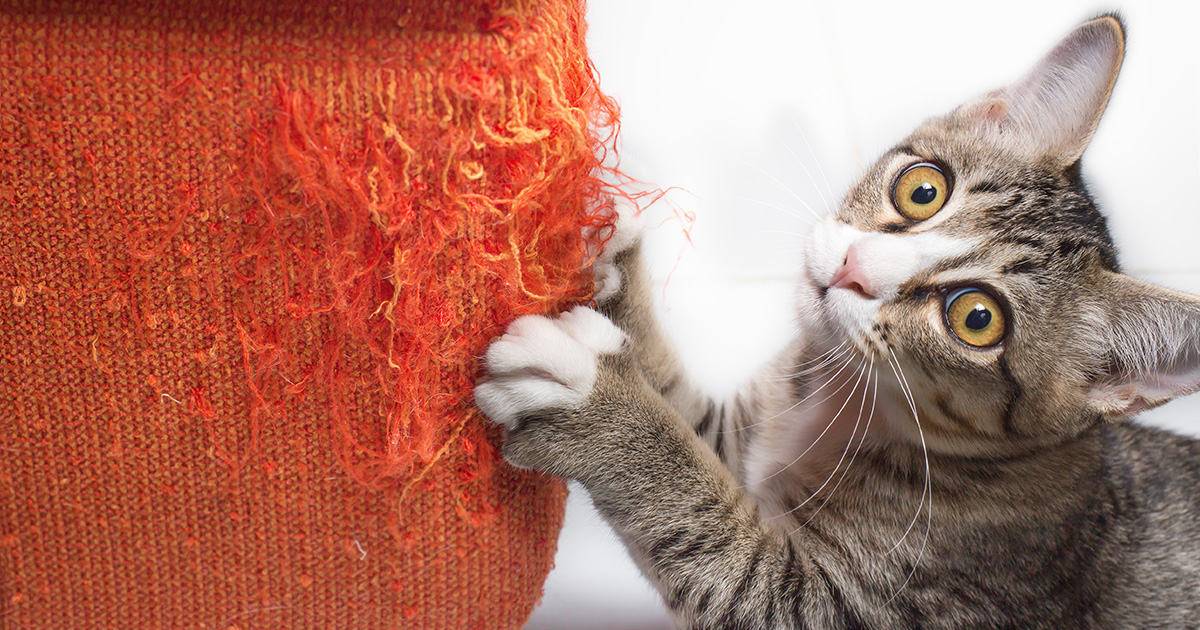For Dogs and Cats
Let’s face it: pets sometimes misbehave. Chewing the remote control or stealing some food from the counter occasionally might cause a few laughs or it might be irritating — but it’s rarely a reason for concern.
If your pet is involved in more destructive behavior or acting inappropriately towards other animals or humans, talking to a professional about it is always the right thing to do. In fact, unacceptable behavior is one of the most common reasons pets are abandoned daily at shelters around the country. Many of those behaviors, however, can be corrected by changing your pet’s environment, addressing issues causing the problem, simple pet training techniques, and/or dealing with underlying medical conditions.
What Problems to Address First
Not all behavior issues are caused by the same thing. Owners are often blamed for their pets’ bad behavior, but some dogs and cats behave the way they do because of an underlying health issue. For example, thyroid imbalances or chronic pain can lead to cat aggression. In cats, a urinary tract infection (UTI) or inflammation of the urinary tract can cause inappropriate behavior, such as house soiling (urinating outside of the litter box). In cases like these, trying to retrain your pet would be useless until the health problem is addressed.
If we suspect there’s a health issue attached to your pet’s behavior, we will recommend a series of tests to figure out what’s going on. Medication or other forms of treatment might be the first step. In some cases, like UTIs, the treatment might be temporary. Other issues, like thyroid problems or arthritis, might require ongoing care to calm an aggressive cat.
Pet Behavioral Issues
If your dog was not enrolled in obedience and training classes as a puppy, he might need some guidance understanding what’s appropriate behavior and what isn’t. Older pets can learn and change their behavior, but it’s important for pet owners to understand this won’t happen overnight. In most cases, addressing pet behavior problems will require daily work, environmental adjustments and retraining not only your pet’s behavior, but also your own.
While many minor behavioral issues can be addressed and handled by owners at home or during group pet training classes, most serious behavior issues should be handled by a professional, such as your veterinarian or a certified pet trainer. One-on-one pet behavior training is by far the most effective course of action you can take to address “bad” behaviors.
The biggest mistake people make regarding pet training is thinking that all training is geared toward the pet. In reality, pet trainers are mostly training you, not just your pet. By training the pet owner on how to properly handle undesirable behaviors, this ensures that the desired behavior will be more likely to occur since the trainer is only with your pet for short periods of time. It is through consistency and repetitiveness that training becomes successful. Pet training is a commitment that pet owners must make to themselves and to their pets if a long lasting bond is to be created and maintained.
Pet Behavior Help
Problem behaviors in dogs, such as jumping or excessive barking, can come on gradually or suddenly. When they happen, it can be stressful for both you and your dog. If your dog has behavioral problems, one-on-one training with a dog trainer may be the best option. Harmony Pet Resort & Spa offers dog training services provided by a certified dog trainer.
Can you train a cat?
Yes! In fact, cats can be just as trainable as dogs, however, they are often motivated by different things. Many cats can be trained with special toys, food, or treats.. While cat owners may not have an interest in teaching commands to their cats, they need to know how to train them to use a litter box. Other things cats can be trained to do could be to not scratch furniture, tolerate carriers or crates, and accepting other cats or dog in the house
Cat training primarily involves behavior modification, specifically problematic behavior. In cats, the most common behavior issue is inappropriate house soiling and scratching furniture. In many cases, inappropriate urination is solved by addressing an underlying health issue and reducing stress and anxiety. Scratching and other destructive behaviors are often addressed by providing appropriate surfaces to scratch, creating a more stimulating environment, increasing exercise, and addressing the cat’s nails by trimming them regularly, applying plastic caps over their nails, or as an absolute last resort, front paw declawing.
For inappropriate urination issues, health problems need to be ruled out prior to assuming it is behavioral. This often includes a thorough physical exam, blood work, urinalysis, a urine culture, x-rays, and sometimes even an abdominal ultrasound. These tests help determine if there is an infection, inflammation, bladder stones, a tumor, or other underlying problem causing the undesirable potty habits.
If no obvious health problem is present based on normal test results, the easiest way to address urinary problems is to look at your environment. Cats are particular and very clean creatures and might refuse to use a litter box if it’s dirty, if they don’t care for the type of litter you are using, or if you have several other cats in the house using the same box.
Tips for Training Your Cat to Use the Litter Box
- Always have one more litter box than you have cats. For example, if you have three cats, you should have at least four litter boxes.
- Litter boxes should be placed in different areas of the house, one on each level, and especially in areas where your cat is soiling. Even if the location of the litter box seems unreasonable, it is often a temporary unappealing location to help resolve a very undesirable behavior. Eventually, once the underlying causes are addressed, litter boxes can be moved to other areas which are more appealing to you.
- The litter boxes should be scooped daily and changed completely once weekly. Use warm water and mild soaps rather than harsh detergents or bleach to clean the boxes.
- You should also try different types of litter in the boxes, one recommended brand is Dr. Elsey’s Cat Attract which often is successful at attracting cats to the litter box.
- In addition, keeping the lid off some or all of the boxes may help.
- For older or arthritic, painful cats using a large, low sided plastic box (ie a sweater box) may make it easier and more comfortable for them to get into and out of the box.
Cats are also prone to stress (sometimes more than dogs), so addressing problems in the home that might be causing stress can result in the problem going away on its own. Stress triggers in cats can be vast and varied. They can be loud noises, overzealous children, new pets or people in the house, or being bullied by more dominant pets in the household. Try your best to identify when your cat is happy and when your cat is stressed, this may give you insight into how to help your cat calm down and feel more at peace in your home.



